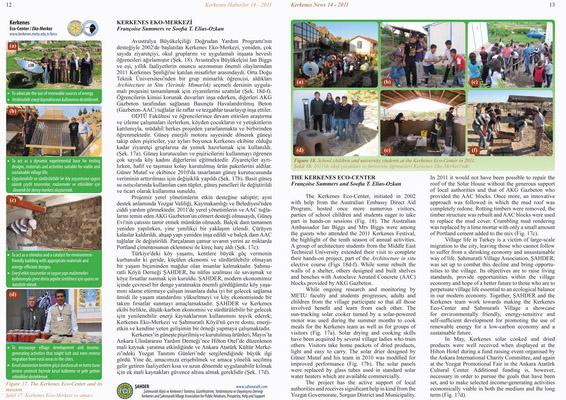| |
THE KERKENES ECO-CENTER
Soofia T. Elias-Ozkan and Françoise Summers
The Kerkenes Eco-Center, initiated in 2002 with help from the Australian Embassy Direct Aid Program, hosted once more numerous visitors, parties of school children and students eager to take part in hands-on sessions (Fig. 18). The Australian Ambassador Ian Biggs and Mrs Biggs were among the guests who attended the 2011 Kerkenes Festival, the highlight of the tenth season of annual activities. A group of architecture students from the Middle East Technical University extended their visit to complete their hands-on project, part of the Architecture in situ elective course (Figs 18d-f). While some rebuilt the walls of a shelter, others designed and built shelves and benches with Autoclave Aerated Concrete (AAC) blocks provided by AKG Gazbeton.
While ongoing research and monitoring by METU faculty and students progresses, adults and children from the village participate so that all those involved benefi t and learn from each other. The sun-tracking solar cooker turned by a solar-powered motor was used during the summer months to cook meals for the Kerkenes team as well as for groups of visitors (Fig. 17a). Solar drying and cooking skills have been acquired by several village ladies who train others. Visitors take home packets of dried products, light and easy to carry. The solar drier designed by Güner Mutaf and his team in 2010 was modifi ed for improved performance (Fig. 17b). The solar panels were replaced by glass tubes used in standard solar water heaters which are available commercially.
The project has the active support of local authorities and receives signifi cant help in kind from the Yozgat Governorate, Sorgun District and Municipality. In 2011 it would not have been possible to repair the roof of the Solar House without the generous support of local authorities and that of AKG Gazbeton who provided the AAC blocks. Once more, an innovative approach was followed in which the mud roof was completely redone. Rotting timbers were removed, the timber structure was rebuilt and AAC blocks were used to replace the mud cover. Crumbling mud rendering was replaced by a lime mortar with only a small amount of Portland cement added to the mix (Fig. 17c).
Village life in Turkey is a victim of large-scale migration to the city, leaving those who cannot follow to suffer from a shrinking economy and unsustainable way of life. Şahmuratlı Village Association, ŞAHDER, was set up to combat this decline and bring opportunities to the village. Its objectives are to raise living standards, provide opportunities within the village economy and hope of a better future to those who are to perpetuate village life essential to an ecological balance in our modern economy. Together, ŞAHDER and the Kerkenes team work towards making the Kerkenes Eco-Center and Şahmuratlı Village a showcase for environmentally friendly, energy-sensitive and self-suffi cient development for promoting the use of renewable energy for a low-carbon economy and a sustainable future.
In May, Kerkenes solar cooked and dried products were well received when displayed at the Hilton Hotel during a fund raising event organised by the Ankara International Charity Committee, and again at the Yozgat Promotional Fair in the Ankara Atatürk Cultural Center. Additional funding is, however, necessary in order to pursue the goals that have been set, and to make selected income-generating activities economically viable in both the medium and the long term (Fig. 17d). |



